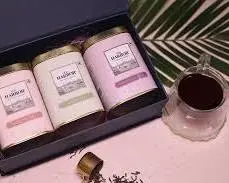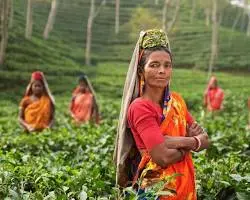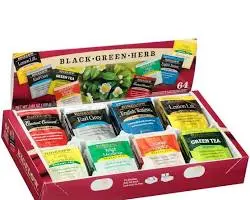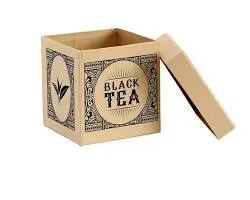India and tea are inseparable. We are the second-largest producer of tea in the world, home to iconic, globally-renowned regions like Darjeeling, Assam, and the Nilgiris. Our tea is a multi-billion dollar export industry, a symbol of national pride, and the fuel for our nation's daily "chai" ritual.
This leads to a confusing question: If we produce so much world-class tea, why is India also one of the world's major importers of tea?
This is the great Indian tea paradox. The answer reveals a sophisticated, two-way global business strategy. This guide will unravel this paradox, detail the A-Z process of exporting tea, and identify the top global buyers for your Indian tea business.

## Part 1: The Paradox Unraveled: Why We Export AND Import
The short answer is: We export our best and import for the rest. We are not just a producer; we are also the world's largest consumer of tea. This creates a massive, complex internal demand that must be met.
Why We EXPORT (The "Premium" Play)
High Value: Indian teas, especially Darjeeling (the "Champagne of Teas") and high-grade Assam Orthodox teas, are premium, luxury products. They command high prices in international markets, far more than what the average Indian consumer would pay for their daily cup.
Global Reputation: Since the British era, Indian tea has had a formidable global reputation. Exporting is a massive revenue-earner and a matter of national prestige.
The Product: We export our high-quality Orthodox teas (full-leaf teas prized by connoisseurs) and premium Assam CTC (Crush, Tear, Curl) teas known for their strong, bright "li-quor."
Why We IMPORT (The "Volume & Value-Add" Play)
Fueling Domestic Demand: India runs on "chai," which is typically made with strong, affordable CTC tea. With over 1.4 billion people, our domestic consumption is colossal—we drink almost 80% of our own production! Sometimes, it is cheaper to import lower-cost CTC teas from countries like Kenya, Vietnam, or Nepal to meet this massive volume demand, especially for the price-sensitive domestic market.
The Re-Export & Blending Game: This is the most important business secret. India is a global hub for tea blending.
Indian companies import cheaper, neutral-tasting teas from other countries.
They blend these with the strong, flavorful Indian teas.
They re-export this "value-added" blend to the world. This allows them to create products that meet specific price points for global markets (like the Middle East) while still maintaining a "Made in India" brand and a strong flavour profile.

Specialty Niche: A tiny fraction of imports consists of specialty teas we don't produce, like specific Oolongs or Matcha, for a niche urban market.
In short: We export our high-margin luxury teas and import low-cost teas to manage domestic price-sensitivity and to use as a "filler" for our value-added re-export blends.
## Part 2: The A-Z Guide to Exporting Tea from India
So, you want to export premium Indian tea to the world? It's a highly regulated but very profitable business. Here is your step-by-step process.
Step 1: Get Your Business Legally Ready
Register Your Company: Form a legal entity (Proprietorship, LLP, Pvt. Ltd. Co.).
Get Your IEC (Importer-Exporter Code): This is your 10-digit mandatory license from the DGFT (Directorate General of Foreign Trade).
GST Registration: A GSTIN is required for all business transactions.
Step 2: The SINGLE Most Important License
Tea Board of India Registration: You cannot export tea without being registered with the Tea Board of India.
You must obtain a Registration-Cum-Membership Certificate (RCMC) from the Tea Board. This is a non-negotiable step that proves you are a licensed and legitimate tea exporter.
Step 3: Sourcing Your Tea
Tea Auctions: You can buy from the major tea auction centers in Kolkata, Guwahati, Siliguri, or Cochin.
Direct from Estates: You can sign contracts directly with tea gardens (estates) in Assam, Darjeeling, etc. This is excellent for ensuring "single-origin" traceability.
Wholesalers: Purchase from large, established tea wholesalers.
Step 4: Know Your Product & HS Code
HS Code: The primary HS Code for tea is in Chapter 09, specifically 0902. This code will change depending on the type (Green Tea, Black Tea, fermented, not fermented, etc.).
Product Types: Be clear on what you're selling: Black Tea (Orthodox/CTC), Green Tea, Oolong, White Tea, etc.
Step 5: Quality, Compliance & Testing (Crucial!)
FSSAI License: You need a Central FSSAI License for all food exports.
Lab Testing: This is your biggest hurdle. Your buyers (especially in the EU & USA) will demand a Certificate of Analysis from a NABL-accredited lab.
MRLs (Maximum Residue Levels): You must test your tea for pesticide residues. The EU, in particular, has extremely strict MRLs. A single failed test can get your shipment rejected and your company blacklisted.
Step 6: Packaging, Labeling & Logistics
Packaging: Tea must be in moisture-proof, food-grade packaging (e.g., aluminum-lined jute bags for bulk, or retail-ready packets).
Labeling: Your labels must comply with the importing country's laws (net weight, country of origin, ingredients, FSSAI logo).
Freight Forwarder: Hire a reliable freight forwarder to handle your shipping, customs clearance, and logistics.
Step 7: Mandatory Export Documents
Commercial Invoice cum Packing List
Bill of Lading (for sea) or Airway Bill (for air)
Certificate of Origin

RCMC from the Tea Board of India
Phytosanitary Certificate: Certifies the tea is free from pests.
Certificate of Analysis (Lab Test Report)
## Part 3: Top 3 Global Buyers for Indian Tea
While India exports tea to over 100 countries, three key players consistently dominate the market.
1. Russia & CIS Nations
Who They Are: Russia has been India's most important and loyal tea customer for decades. The "CIS" includes countries like Kazakhstan and Ukraine.
What They Buy: They are the #1 importers of Indian Orthodox tea and also buy significant volumes of strong Assam CTC. They prefer traditional, strong black teas.
Market Nuance: This is a long-standing, volume-driven relationship built on a traditional taste for strong Indian black tea.
2. United Arab Emirates (UAE)
Who They Are: The UAE (specifically Dubai) is not a massive tea-drinking nation itself. It is the world's #1 re-export hub.
What They Buy: They import massive quantities of Indian CTC tea. This tea is brought to Dubai, blended (often with cheaper teas from other regions), packaged, and then re-exported to the entire Middle East, North Africa (MENA), and Iran.
Market Nuance: This is a highly competitive, price-sensitive B2B market. They are your gateway to the entire Middle Eastern region.
3. United States of America (USA)
Who They Are: The USA is a high-growth, high-value market.
What They Buy: They are not buying cheap CTC for "chai." They are buying premium, high-margin products:
Single-Origin Darjeeling
Organic Green & Black Teas
Specialty Blends (e.g., "Masala Chai" blends)
Wellness Teas (with herbs like turmeric, ginger)

Market Nuance: The US buyer pays a premium for quality, story, and certifications (Organic, Fair Trade). This is where you sell your best-branded, highest-quality teas.
## Conclusion: A Strategy of Two Halves
India's role in the global tea market is a brilliant, complex strategy. We protect our domestic market and our blending industry by importing lower-cost teas. Simultaneously, we leverage our centuries-old reputation to export our premium, high-value teas to the world.
For an exporter, the path is clear: focus on quality, get your certifications right, and build a brand that the world is waiting for.